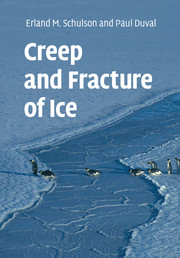Book contents
- Frontmatter
- Contents
- Preface
- Acknowledgements
- 1 Introduction
- 2 Structure of ice
- 3 Microstructure of natural ice features
- 4 Physical properties: elasticity, friction and diffusivity
- 5 Plastic deformation of the ice single crystal
- 6 Ductile behavior of polycrystalline ice: experimental data and physical processes
- 7 Modeling the ductile behavior of isotropic and anisotropic polycrystalline ice
- 8 Rheology of high-pressure and planetary ices
- 9 Fracture toughness of ice
- 10 Brittle failure of ice under tension
- 11 Brittle compressive failure of unconfined ice
- 12 Brittle compressive failure of confined ice
- 13 Ductile-to-brittle transition under compression
- 14 Indentation fracture and ice forces on structures
- 15 Fracture of the ice cover on the Arctic Ocean
- Index
- References
12 - Brittle compressive failure of confined ice
Published online by Cambridge University Press: 01 February 2010
- Frontmatter
- Contents
- Preface
- Acknowledgements
- 1 Introduction
- 2 Structure of ice
- 3 Microstructure of natural ice features
- 4 Physical properties: elasticity, friction and diffusivity
- 5 Plastic deformation of the ice single crystal
- 6 Ductile behavior of polycrystalline ice: experimental data and physical processes
- 7 Modeling the ductile behavior of isotropic and anisotropic polycrystalline ice
- 8 Rheology of high-pressure and planetary ices
- 9 Fracture toughness of ice
- 10 Brittle failure of ice under tension
- 11 Brittle compressive failure of unconfined ice
- 12 Brittle compressive failure of confined ice
- 13 Ductile-to-brittle transition under compression
- 14 Indentation fracture and ice forces on structures
- 15 Fracture of the ice cover on the Arctic Ocean
- Index
- References
Summary
Introduction
Compressive failure more often than not occurs under a multi-axial state of stress. For example, during the interaction between a floating ice feature and an engineered structure, material within the contact zone is compressed not only along the direction of impact, but also in orthogonal directions, owing to constraint imposed by surrounding material. The confinement induces biaxial (thin feature, wide structure) and triaxial (thick feature, narrow structure) stress states, which, as we show below, have a large effect on the strength of the ice and on its mode of failure.
This is not surprising. Based upon the failure of unconfined material and on the importance to that process of frictional crack sliding cum the development of secondary cracks (Chapter 11), confinement plays two roles: it lessens the excess or effective shear stress that drives sliding; and it lowers the mode-I stress intensity factor that drives crack growth. Higher applied stresses are thus required to activate the mechanism. Also, in holding the ice together, confinement promotes the development of shear faults. Indeed, very little confinement is required (Wachter et al., 2008), to the effect that from a practical perspective faulting and not axial splitting is the more important failure mode.
In this chapter we review the observations and their interpretation. We again begin with a short discussion of experimental methods, and then quantify the effects of confinement on the behavior of both granular and columnar polycrystalline ice.
Information
- Type
- Chapter
- Information
- Creep and Fracture of Ice , pp. 266 - 319Publisher: Cambridge University PressPrint publication year: 2009
